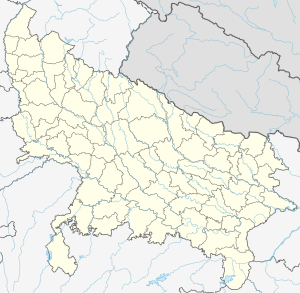
Unnao Junction railway station

Unnao Junction | |||||||||||||||||||||
|---|---|---|---|---|---|---|---|---|---|---|---|---|---|---|---|---|---|---|---|---|---|
| Indian Railways junction station | |||||||||||||||||||||
 | |||||||||||||||||||||
| General information | |||||||||||||||||||||
| Location | SH 38, Unnao, Uttar Pradesh India | ||||||||||||||||||||
| Coordinates | 26°32′57″N 80°29′12″E / 26.5491°N 80.4867°E | ||||||||||||||||||||
| Elevation | 129 metres (423 ft) | ||||||||||||||||||||
| Owned by | Indian Railways | ||||||||||||||||||||
| Operated by | Northern Railway | ||||||||||||||||||||
| Line(s) | Varanasi–Kanpur branch line Lucknow–Kanpur Suburban Railway Unnao–Balamau line Unnao–Raebareli line | ||||||||||||||||||||
| Platforms | 5 | ||||||||||||||||||||
| Tracks | 7 | ||||||||||||||||||||
| Construction | |||||||||||||||||||||
| Structure type | Standard on ground | ||||||||||||||||||||
| Parking | Yes | ||||||||||||||||||||
| Bicycle facilities | No | ||||||||||||||||||||
| Other information | |||||||||||||||||||||
| Status | Functioning | ||||||||||||||||||||
| Station code | ON | ||||||||||||||||||||
| Division(s) | Lucknow NR | ||||||||||||||||||||
| History | |||||||||||||||||||||
| Opened | 1867: 154 YEARS | ||||||||||||||||||||
| Electrified | 1999–2000 Double Line-Electrified | ||||||||||||||||||||
| Previous names | Indian Branch Railway Company | ||||||||||||||||||||
| Services | |||||||||||||||||||||
| |||||||||||||||||||||
| |||||||||||||||||||||
Unnao Junction Railway Station, also known as Unnao Railway Station, is a major railway station located in Unnao district in the Indian state of Uttar Pradesh. It serves Unnao and the surrounding areas. The station falls under the jurisdiction of the Northern Railway zone of the Indian Railways and serves as a crucial transportation hub for the region. Unnao Junction railway station is on the Lucknow–Kanpur Suburban Railway and Varanasi–Kanpur branch line.

History
In 1867, the Indian Branch Railway Company opened the Kanpur–Lucknow line.[1]

The Oudh and Rohilkhand Railway opened the line from Varanasi to Lucknow in 1872.[2]

The history of Unnao Junction Railway Station dates back to the 19th century, when the British colonial government started laying railway lines across India to facilitate transportation and trade. The first railway line in the region was laid in 1867, connecting Kanpur to Lucknow. The line passed through the present-day site of Unnao Junction, but there was no station there at the time.

During the Indian Independence movement, Unnao Junction played a significant role in transporting people and goods to different parts of the country. The station witnessed several important events, including the Quit India Movement and the Non-Cooperation Movement.

In 1890, the North Indian Railway Company, which was responsible for the construction and maintenance of railway lines in the region, decided to build a station at Unnao Junction to facilitate passenger and goods traffic. The station was built in a colonial style, with a single platform and a small booking office.

Over the years, the station underwent several renovations and upgrades to keep up with the increasing demand for railway services. In the 1950s, the station was expanded to include multiple platforms and an array of modern amenities, such as waiting rooms, refreshment stalls, and restrooms.

Today, Unnao Junction Railway Station is a major railway hub, serving thousands of passengers every day. It is served by several long-distance trains, connecting it to major cities like Delhi, Mumbai, Kolkata, and Chennai, as well as smaller towns and villages in the region. With its rich history and modern facilities, the Unnao Junction railway station continues to play a vital role in the development of the region.

Lines
- Unnao - Lucknow line*: This line connects Unnao Junction to the state capital of Lucknow, which is located approximately 60 km away. Several passenger and express trains operate on this line, making it a convenient and popular mode of transport for commuters traveling between the two cities.
- Unnao - Kanpur line*: This line connects Unnao Junction to Kanpur, which is one of the largest cities in Uttar Pradesh. This line is an important transport route for the region and offers several passenger and express trains connecting Unnao to Kanpur.
- Unnao - Prayagraj line^: This line connects Unnao Junction to Prayagraj, one of the holiest cities in India. The line offers some passenger and express trains, like Prayagraj Sangam Intercity, Unchahar Express, Prayagraj Sangam Express Special
- Unnao - Varanasi line: This line connects Unnao Junction to Varanasi, one of the oldest cities in the world and an important religious center in India. Currently no direct train between Unnao and Varanasi is operated on this line.
- Unnao-Balamau line: The Unnao-Balamau railway line is a branch line that connects Unnao Junction with Balamau Junction, both located in the state of Uttar Pradesh. The total length of the line is approximately 77 km, and it is a single-line, electrified route. The line was opened in the late 19th century and was initially constructed as a narrow-gauge line. However, it was later converted to broad gauge.
- Unnao-Rae Bareli line^: The Unnao-Rae Bareli railway line is a single-line, non-electrified branch line that connects Unnao Junction with Rae Bareli Junction, both located in Uttar Pradesh. The total length of the line is approximately 63 km. The line was opened in the late 19th century and was initially constructed as a narrow-gauge line. However, it was later converted to broad gauge.
* Unnao-Lucknow line and Unnao-Kanpur line are portions of the Lucknow-Kanpur Suburban Railways. Unnao Junction acts as a major intermediary station on this line.

^ Unnao Raebareli line and Unnao Prayagraj line are part of the Kanpur-Varanasi Branch Line. The Unnao-Raebareli line originates and terminates at Unnao Junction, while the Unnao-Prayagraj line extends to Kanpur Central.

Electrification
The electrification of the rail line passing through Unnao Junction began in the 1970s as part of the Indian Railways' plan to electrify all major rail routes in the country. The electrification work was carried out in phases and took several years to complete.

The first phase of electrification between Lucknow and Kanpur was completed in 1971, and this helped to increase the speed and efficiency of trains passing through Unnao Junction.

The Kanpur–Kanpur Bridge–Unnao–Lucknow section was electrified in 1999–2000. The electrification work on the remaining section of the line passing through Unnao Junction was carried out in subsequent years.

References
- ^ "IR History: Early History (1832–1869)". IRFCA. Retrieved 20 June 2013.
- ^ "IR History: Early Days II (1870–1899)". IRFCA. Retrieved 20 June 2013.
External links
- Trains at Unnao
 Unnao travel guide from Wikivoyage
Unnao travel guide from Wikivoyage
See what we do next...
OR
By submitting your email or phone number, you're giving mschf permission to send you email and/or recurring marketing texts. Data rates may apply. Text stop to cancel, help for help.
Success: You're subscribed now !


